What Data Is Google Analytics Goals Unable to Track: Learn the Limitations
What Data Is Google Analytics Goals Unable to Track: Learn the Limitations
Blog Article
Revealing the Blind Destinations: Recognizing What Google Analytics Goals Can not Gauge
In the world of electronic analytics, Google Analytics stands as a powerful device for tracking and analyzing on-line individual interactions. Recognizing what Google Analytics goals can not gauge is vital for acquiring a comprehensive sight of user actions and engagement.
Customer Habits on External Operatings Systems
Comprehending just how individuals connect on outside platforms is critical for optimizing on-line techniques. Exterior systems, such as social networks networks, reference web sites, and online discussion forums, play a considerable duty in driving web traffic to a firm's site. By assessing user actions on these systems, companies can acquire beneficial insights right into the efficiency of their advertising and marketing efforts and the preferences of their target market.
One key aspect of individual actions on outside systems is the referral resource. By tracking where the customers are coming from, businesses can determine which systems are driving the most traffic to their web site. This details can help firms allot their resources better, concentrating on the systems that generate the most effective results.

Offline Conversions and Communications
Examining user actions on outside platforms gives important understandings into online methods; however, taking into consideration offline conversions and interactions is just as critical for a detailed understanding of a company's general efficiency. Offline conversions, such as in-store purchases or phone questions, play a significant duty in numerous services' success.

Attribution Beyond Last Click
When delving into the world of digital marketing analytics, it ends up being necessary to look beyond the single touchpoint of the last click for a much more comprehensive understanding of attribution. While Google Analytics offers useful understandings into individual habits, counting only on last-click attribution can be limiting - what data is google analytics goals unable to track. Acknowledgment versions that go beyond the last click provide a much more nuanced view of the client trip, considering all the touchpoints that lead to a conversion
Attribution beyond the last click allows marketing professionals to designate credit rating to different interactions along the conversion path, giving a clearer image of the efficiency of different marketing channels. By exploring multi-touch acknowledgment designs such as linear, time decay, or position-based acknowledgment, have a peek at this website services can better allocate their marketing spending plans and enhance their techniques for optimal effect.
Understanding the impact of each touchpoint in the conversion procedure is important for making informed choices and optimizing ROI. By accepting acknowledgment beyond the last click, businesses can obtain deeper insights right into consumer behavior and customize their marketing initiatives better.
Cross-Device and Cross-Browser Tracking

In a similar way, cross-browser monitoring enhances cross-device monitoring by capturing customer behavior as they switch between different web browsers. Comprehending just how customers connect with websites on various browsers can help marketing experts maximize their on-line experiences to ensure uniformity and capability throughout various platforms.
Qualitative Data and Individual Intent
Understanding user intent through qualitative data evaluation is crucial for developing targeted electronic marketing strategies that reverberate with the demands and choices of the target market. Qualitative data provides understandings right into the 'why' behind customer activities, dropping light on motivations, emotions, and choices that measurable data alone can not capture. By analyzing user responses, remarks, and interactions, online marketers can uncover beneficial info concerning customer intent, enabling them to customize their messaging, content, and offerings to much better line up with what their target market is looking for.
Qualitative data also aids in comprehending the context in which users involve with a web site or app. This contextual understanding makes it possible for marketing professionals to create more relevant and individualized experiences, ultimately driving greater interaction and conversion prices. By delving into individual intent through qualitative information analysis, services can my link gain a much deeper understanding of their target audience, bring about a lot more effective advertising strategies that satisfy customers' requirements and assumptions.
Conclusion
In final thought, Google Analytics goals have restrictions in gauging user habits on exterior platforms, offline conversions, acknowledgment beyond last click, cross-browser and cross-device tracking, and qualitative information associated with user intent. what data is google analytics goals unable to track. It is necessary for businesses to be aware of these blind places in order to supplement their data evaluation with various other tools and techniques to get a much more extensive understanding of their target market and boost their overall digital advertising approaches
By analyzing user actions on these platforms, services can get beneficial insights into the effectiveness of their advertising initiatives and the choices of their target audience.
Analyzing individual habits on exterior systems gives valuable insights right into online strategies; however, thinking about offline conversions and communications is similarly important for an extensive understanding of a business's general performance.In digital marketing analytics, moving past last-click acknowledgment to discover cross-device and cross-browser monitoring is necessary for getting an alternative understanding of individual interactions across various systems and tools. By examining individual feedback, comments, and communications, marketers can reveal beneficial info regarding individual intent, allowing them to customize their messaging, material, and offerings to better align with what their target market is looking for.
By delving right into customer intent with qualitative data analysis, organizations can get a deeper understanding of their target audience, leading to more reliable advertising strategies that fulfill individuals' assumptions and needs.
Report this page